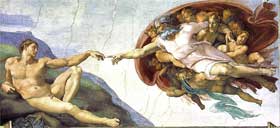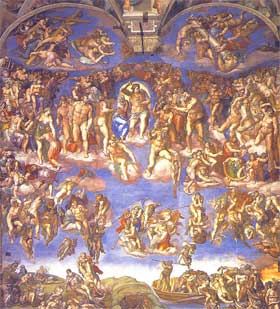Michelangelo - Paintings
The ceiling in the Sistine Chapel is the most celebrated of Michelangelo's paintings. Allowing for all interruptions, he was working on the Sistine Chapel from 1509 to 1512, from the inception to the final uncovering. The walls had already been decorated by various masters whose works remain.
The tradition has grown of Michelangelo having painted the ten thousand square feet of vault surface unaided. But, of course, it is not so. The mechanical necessities called for help, and he must have used it.
Pope Julius followed the work constantly, and the chapel went on, the vault being completed within the date that we know: October, 1512. The artist speaks of his having endured "great hardships, illness, and overwhelming labour."
It is, notwithstanding, the most extraordinary piece of technical work ever accomplished, both in perfection of handling and in the fabulous rapidity of the execution. Some of the most important and celebrated of the giant figures which fill this space have been painted within two or four days, and their finish is as admirable as their conception. It is the finish of the great master.

Michelangelo
The Creation of Adam
The Sistine Chapel, Vatican
We feel that the evolution of the master's own mind is written out in the subjects and in the figures of the great painting. We shall never know exactly, and the form of art that he employed must always be mysterious in its absolute meaning, so that it presents intentions that vary according to the mind of him who looks at it. The whole scheme is that of a picture, according to the Bible, of the Creation of Man, his having sinned, his being punished, his being admonished, his obstinacy in evil; and also of the hope of escaping from sin, held out by the Prophets; of a better day in which sin shall dwindle, promised by the Prophets of the Law, and by the Sibyls of the so-called Pagan world, who represent the constant aspiration of all mankind toward good and the hope of its final triumph.
This vast story is told in the form of a decoration. So that the poetic designs, the dramatic expositions, the tragic figures are in reality subsidiary parts of architectonic divisions and ornamental setting. This is not visible to our mind. We have grown away, or fallen away, from the greater ideas of subservience to unity; the modern mind, meaning thereby the average artistic practitioner of to-day, would make the story-part of his work - what we call the picture - so important as to destroy the sense of a wall-embroidery.
The greater man, capable of innumerable stories and master of the drama, has, on the contrary, made all the pictures, which themselves are among the celebrated works of man, subject to a great plan of ornamentation.
It is the richest in planning ever made. The resources of the arts of architecture, sculpture, and painting have been called upon to unite in one great patterning of the ceiling. The feeling of sculpture is as complete as if these many figures had been in reality carved, but it is only a feeling. There is only the slight deception necessary to bind them to the simulated architecture, which, itself merely decorative, is still the web of the entire work. This sculpture and architecture is represented by painting, which in turn is treated with the science of pictorial works. Nowhere, even with the greatest colorists, has a bolder and more logical use of the divisions of light which we call the colors been applied to a surface. The unity is so great, the balance of effects so harmonious, that it is only by study that we see expressed in the methods of this painting the ancient rules, handed down by practice, which unite with the latest teaching of modern scientific coloring.
But besides the Prophets and Sibyls and ancestors of the Christ, the ornamentation consists largely of representations, more or less nude, of the human form treated as if interchangeable with any conventional shape, as if one shape were as easy to give as another. Through all the rest, Michelangelo's originality is based on the previous work of Italy back to the obscurest intentions of the Middle Ages. The half-expressed desires of earlier sculptors are here completed. We think of this great work as the flowering of the Renaissance. It is in reality the last expression of the impulse and feeling of Medieval Europe. But it is expressed in a new rhythm of form, that beats through every figure, and with a knowledge of structure and a representation unknown before. The extraordinary love of beauty that possessed the artist, his sensitiveness to the wonders of the human form, cover the deeper feelings which he had in common with the men of a more intense past.
The greatest of Michelangelo's paintings had thus been finished at the end of 1512. The effect on the world of Rome and on the whole Italy is one of the great triumphs of art. Artists recognized that a new style had been introduced, and that the limits of the art of painting had extended beyond their dreams. It is one of the intellectual honors of Italy that this was recognized on that very day, and that Michelangelo was placed almost where he is now.
The Last JudgmentThe previous Pope Clement, after much meditation upon subjects, chose the "Last Judgment" for the theme of the wall-painting above the altar of the Sistine Chapel. Then Paul III. ordered the work to be carried out by Michelangelo. While the necessary slow preparations of the wall were made, Michelangelo labored in secret on the tomb of Pope Julius, that one desire of his heart which he was never to see finished as he had planned. Michelangelo was at work on the great painting in 1536, and it was completed in 1541. Few works of art have elicited more contradictory admiration. When completed it seemed to the artists of the day a grammar of the representation of the human body. All the old man's knowledge of anatomy and of the movement of the human body appeared to the men of his day to be expressed in this great document of learning. The painting was not only a monument of consummate learning, never equaled, but was painted with an ease and rapidity astonishing even in that period of most accomplished workmen.

Michelangelo
The Last Judgment
Here, we can follow the artist's confidence in his own powers, which we can gauge most accurately, as the methods of fresco allow us to tell just how much work the
painter does in a day. Its execution is as careful and delicate as if it were slow work, while we know that some of these gigantic figures, replete with observation of
detailed facts, have been painted in a single day. This touches a point of his character, a side of the mind or soul, that forced him, as it has others, to a
fierce concentration of will and sentiment, which, increasing the interest taken, drove attention and memory to an extreme unused by the ordinary mind, except at moments
of great danger or great exaltation. And these great days of work the artist paid for by other days of fatigue. He says of himself some years before:
"I have much work to do and am old and unwilling, so that if I work for a day I must rest for four." This capacity for overstraining followed
Michelangelo through all his life and all his work.
Not only is the painting the greatest example of a certain side of all art and the most consummate representation of the learned art of the time, but it is the last limit reached in the conveying of personal sentiment. Perhaps on that side the great work was understood only by a few, but who can tell? The Pope himself followed it with interest, and personally understood the terrible meaning conveyed in a subject not usually placed over the altar of Redemption. The Pope was also a lover of art, understanding, perhaps, the intentions of the painter, and his representation of all these figures as mostly nude seems to have been accepted not only with sympathy, but with the defense of the artist, accused by Cardinal Carafa of immorality and obscenity. It may be that in the revolution of thought and taste nothing but the conservatism of Rome has saved the painting against the protests condemning the work as obscene.
In Michelangelo's paintings, the body is used absolutely, as a musician uses notes to express emotion. Perhaps separated more and more from other men and resorting less and less to nature and to observation, he has not mitigated his own strenuous feeling by passing it into something seen. The figures of the Last Judgment are more decidedly abstractions of feeling. But what fitter decoration could be used for the chapel of the successor to the keys of Saint Peter? What better exposition over ceiling and wall of the idea of responsibility? What greater reminder of the seriousness of obligation, of the necessity of a final accounting before which even "the just shall scarcely be secure"? "Vix justus sit securus."
The sweetness of the earlier work does not appear in the later design above the altar; but the other great meanings are told without flinching. Pope and prince can read them written large. The Christ above is now the Eternal Judge. Death and Hell rise from their sleep below His throne. Before His gesture even the elect tremble, and Mary feels her own lowliness as a creature. Peter pleads the duties of his office; each martyr begs his testimony remembered. Whatever prelate looked at the gigantic painting could see that its significance was the same as that of the hymn sung about him, and that before its meaning all men were alike. "Thou who didst forgive the prostitute and the thief, to me also the just and the virtuous, thou hast given a hope."
How much it says that this story has hung above the Popes officiating in splendor of office; accepted as preaching the severe doctrine of the Church which allows no position and no sanctity to be free from reproach and from possibility of sin.
The fame of the Last Judgment spread through Italy as before had happened with each of the other Michelangelo's paintings. Again he was acclaimed as the one great master, notwithstanding those murmurs of dissatisfaction which began then and which will always last, so long as we do not understand the terrible sermon preached in this picture, not meant to please but to impress.